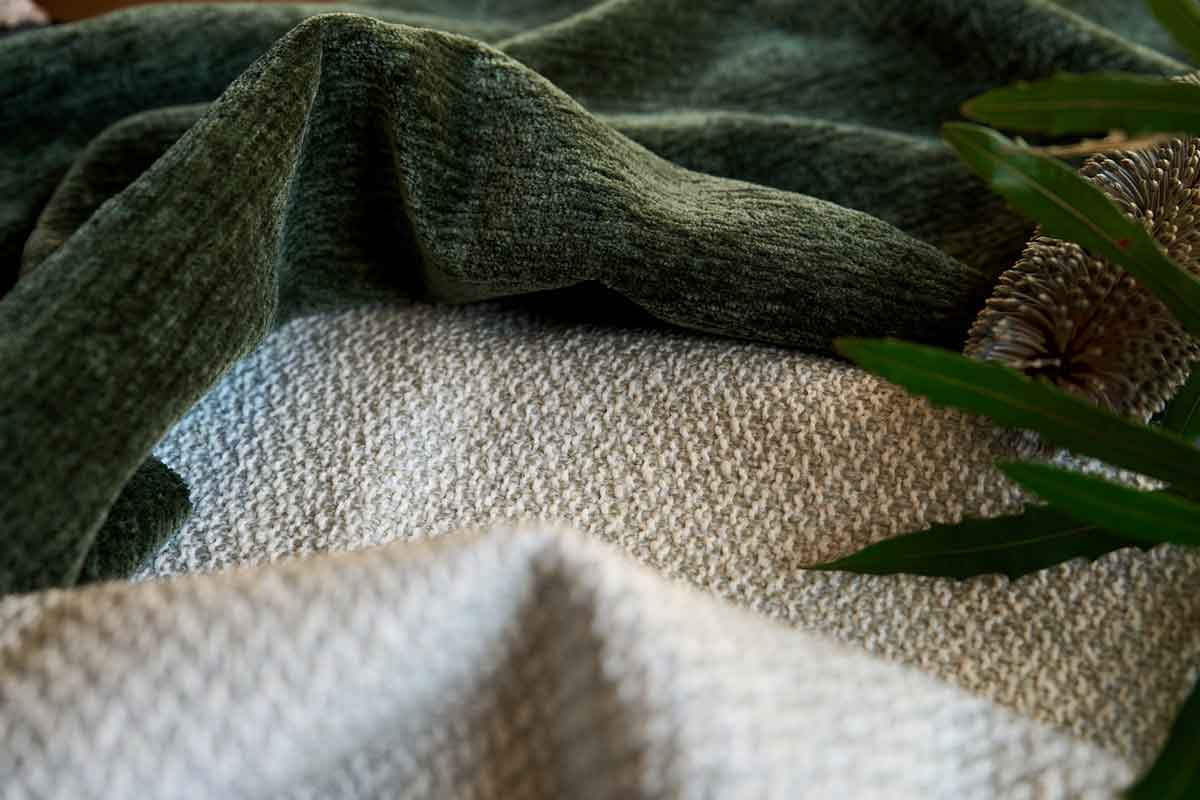5 things to know about fabric pilling
Wondering why your fabrics are pilling? Pilling or pills are the tiny fuzzballs that appear on fabric products, including clothing, bedding and sofas – and these fuzzballs can cause many concerns.
This article is here to help answer how to identify what causes pilling, how to remove pills, and prevent pilling from occurring.
1. What causes pilling on fabric?
Pilling occurs when the fibres in the fabric rub together, and the friction causes the fibres to become loose and ball up.
This friction occurs through general use. Whether you sit or lie on your sofa, your skin and clothes come in contact with the material, which creates friction and normal abrasion resulting in pills.
Fibre transfer can also cause pilling on your fabric sofa. This occurs when loose fibres from your clothes, blankets, cushions or throws attach to the sofa fabric resulting in pilling.
Pills from fibre transfer can be a different colour to your sofa material—this will depend on the colour of the transferred fibres, your throws, clothing and cushions.
2. Is fabric pilling a fault?
While pilling can be bothersome, it is not considered a fault or defect. As pilling is not a fault, your furniture warranty will not cover fabric pilling.
Pilling occurs on various fabric and material products, including garments, rugs, and mattresses. As a result, there are many tools available to help remove pills from your material and fabric items.
3. How to prevent fabric pilling on your sofa
Whether you sit on your sofa twice a day or twice a month, most sofa materials have the potential to pill. The friction from general use causes fibres to rub together and ball up.
Pilling is unavoidable, but there are some things you can do to prevent repeated friction and abrasion to keep the pilling on your sofa to a minimum.
- Rotate seat cushions and back cushions to even out wear – this is particularly important if you sit or lounge in the same spot. Rotating the sofa cushions prevents one section of your sofa from becoming more worn than other sections.
- Be mindful of your cushion and throw materials – throws and blankets can cause additional friction, which can be the catalyst for pills appearing more prominently in one area. Different materials are courser and more abrasive than others. Some throw and cushion materials may also have looser fibres, which can cause pilling from fibre transfer.
- Regular vacuuming – as dirt and dust can also cause friction, we recommend vacuuming and cleaning your sofa regularly to remove any foreign matter. Regularly vacuuming your sofa will also help remove loose fibres before they ball up and create pills.
4. How to remove pills from fabric
There are three main ways to removing pills from your furniture fabric.
- Use the correct cleaning products – when cleaning your sofa with a fabric cleaner or applying a fabric protectant, it is essential only to use products designed for your fabric and sofa. Harsh chemicals, bleach, and cleaners not intended for material can weaken or break the fibres. The loose and broken fibres will ball up and make their way to the surface resulting in pills.
- Use a fabric pill remover – one of the most efficient ways to remove pills from your sofa is to use a fabric pill remover. Also known as a de-pilling machine, a pill remover gently shaves the pills and loose fibres without damaging the rest of the fabric or your sofa. We recommend using the pill remover in a gentle circular motion without applying too much pressure to the fabric. For best results, work a small section at a time and run your hand over the treated area to feel the fabric is smooth and all the pills are removed.
- Vacuum weekly with low suction and a soft brush accessory – this will help keep your sofa clean and reduce the appearance of pills. We recommend avoiding using your vacuum in a high-suction setting as this may remove or break extra fibres.
5. Does pilling weaken fabric?
Pilling is a normal occurrence caused by general wear and tear and does not affect the durability or functionality of the fabric.
Pilling may appear more frequently and extensively in the few months of owning your sofa. This may subside once the excess loose fibres move to the surface and get removed.
While some fabrics will settle after the first few months, pilling can still occur, particularly if your sofa repeatedly comes in contact with throws, blankets or abrasive clothing.
How to select fabric for your sofa
As bothersome as pilling might be, the tiny fuzzballs should not cause concern or prevent you from enjoying your fabric sofa.
While all fabrics have the potential to pill, some textiles are more prone to pilling than others.
If you need help selecting the right fabric for your sofa, you can book a Showroom consultation online or speak to one of our interior design consultants. Our team can help you select the right material for your home and needs.
At King Living all our fabrics undergo an extensive fabric pilling and quality test by three independent laboratories before being approved as a King Living fabric and made available to our customers. While pilling is natural and can occur on most fabrics, we select quality fabrics and conduct these tests to alleviate the risk of excessive pilling.
All King Living fabrics feature pilling ratings of three stars or above, which is considered suitable for everyday furniture use.
If you are unsure if a fabric sofa is right for your sofa, you can read our leather vs fabric article to help make more of an informed decision.












